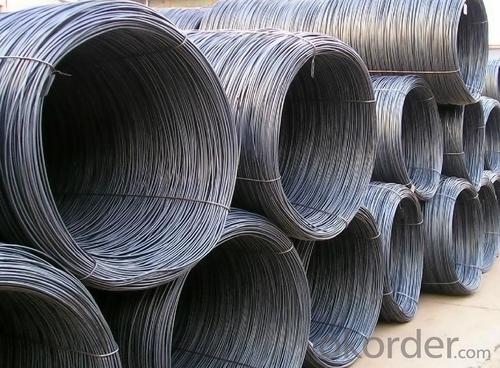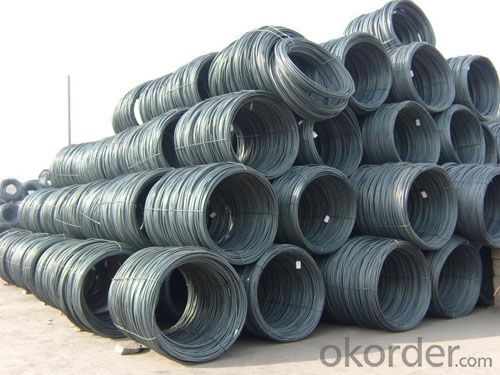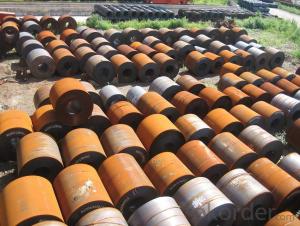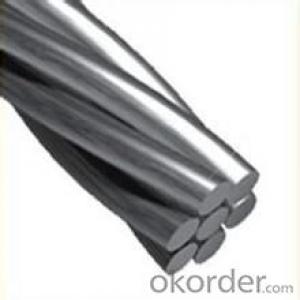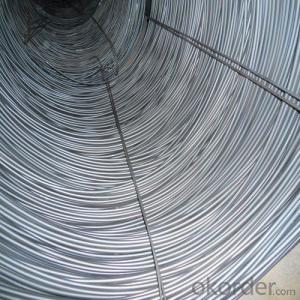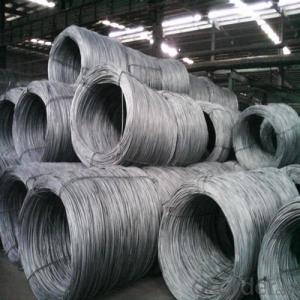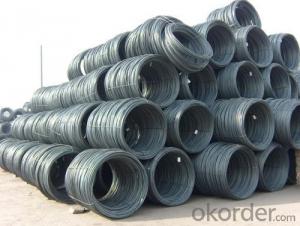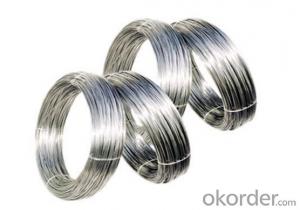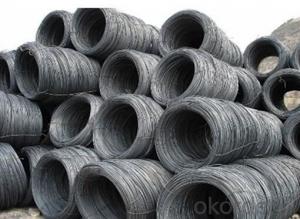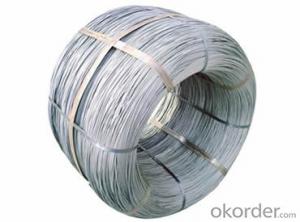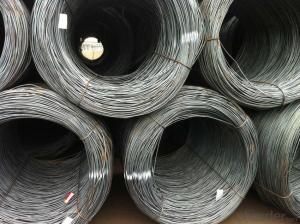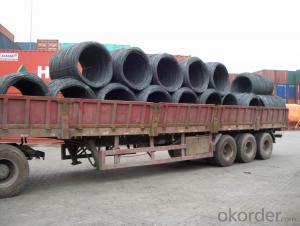Hot Rolled Carbon Steel Wire Rod 8mm with High Quality
- Loading Port:
- China Main Port
- Payment Terms:
- TT or LC
- Min Order Qty:
- 20 m.t.
- Supply Capability:
- 20000 m.t./month
OKorder Service Pledge
OKorder Financial Service
You Might Also Like
Product Description:
OKorder is offering Hot Rolled Carbon Steel Wire Rod 8mm with High Quality at great prices with worldwide shipping. Our supplier is a world-class manufacturer of steel, with our products utilized the world over. OKorder annually supplies products to European, North American and Asian markets. We provide quotations within 24 hours of receiving an inquiry and guarantee competitive prices.
Product Applications:
Hot Rolled Carbon Steel Wire Rod 8mm with High Quality is widely used in construction and manufacturing. Carbon steel wire rod is mainly used for reinforcement of reinforced concrete and welded structure or reprocessed (roberts , nail, etc.) materials, especially used to produce wire drawing, welding electrode, nails, spring, electronic, precise machinery parts and so on.
Product Advantages:
OKorder's Hot Rolled Carbon Steel Wire Rod 8mm with High Quality are durable, strong.packed and suitable for wire mesh,nail manufacture and construction
Main Product Features:
· Premium quality
· Prompt delivery & seaworthy packing (30 days after receiving deposit)
· Can be recycled and reused
· Mill test certification
· Professional Service
· Competitive pricing
Product Specifications:
Manufacture: Hot rolled
Grade: SAE1006 SAE1008 SAE1010 SAE1012 SAE1016 SAE1018
Certificates: ISO, SGS, BV, CIQ
Weight per Coil:2-2.05tons
Packaging: Export packing, packed by coil
FAQ:
Q1: Why buy Materials & Equipment from OKorder.com?
A1: All products offered byOKorder.com are carefully selected from China's most reliable manufacturing enterprises. Through its ISO certifications, OKorder.com adheres to the highest standards and a commitment to supply chain safety and customer satisfaction.
Q2: How do we guarantee the quality of our products?
A2: We have established an advanced quality management system which conducts strict quality tests at every step, from raw materials to the final product. At the same time, we provide extensive follow-up service assurances as required.
Q3: How soon can we receive the product after purchase?
A3: Within three days of placing an order, we will begin production. The specific shipping date is dependent upon international and government factors, but is typically 7 to 10 workdays.
Q4: How many tons can be loaded into one 20ft container?
A4: Around 18—20tons
Q5: What is the chemical composition?
A5:
C:0.10%max Mn:0.32% max S:0.045%max P:0.040%max Si:0.30%max
Images:
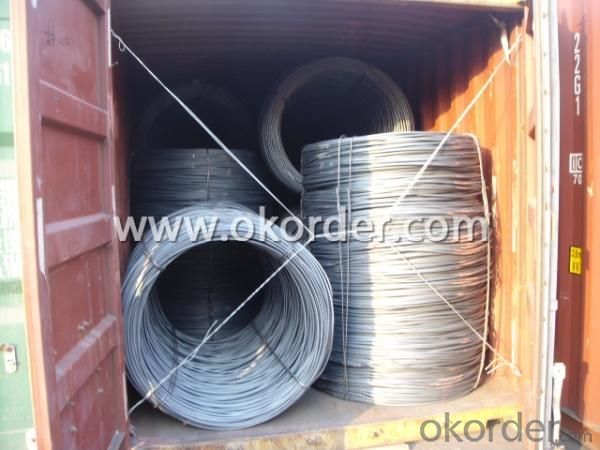
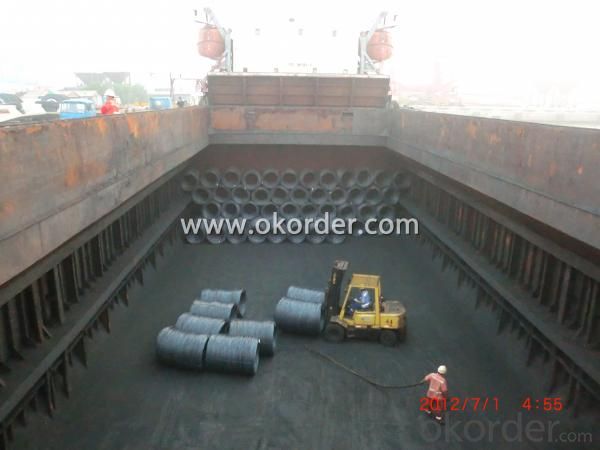
- Q: What are the different production processes involved in steel wire rod manufacturing?
- The manufacturing of steel wire rods involves several production processes. These processes are crucial in transforming raw materials into the final product. Here are the different production processes involved in steel wire rod manufacturing: 1. Ironmaking: The steel wire rod manufacturing process begins with ironmaking. Iron ore is extracted and processed in a blast furnace to produce pig iron. The pig iron is then further refined to remove impurities and create steel. 2. Steelmaking: In the steelmaking process, the pig iron is melted in a furnace and alloyed with various elements such as carbon, manganese, and silicon to achieve the desired steel properties. This process ensures that the steel meets the specific requirements of wire rod production. 3. Continuous Casting: After steelmaking, the molten steel is cast into billets or blooms using continuous casting technology. This process involves pouring the molten steel into a water-cooled mold to solidify it into a specific shape. For wire rod production, the billets are typically cast in a square cross-section. 4. Hot Rolling: The next step is hot rolling, where the billets are reheated and passed through a series of rolling mills. These rolling mills reduce the billets' cross-sectional area and elongate them into wire rod form. The hot rolling process improves the mechanical properties and surface finish of the wire rods. 5. Cooling: Once the wire rods are hot rolled, they undergo a cooling process to achieve the desired properties. Cooling can be done through air cooling or water spray cooling, depending on the specific requirements of the wire rods. 6. Surface Treatment: After cooling, the wire rods undergo surface treatment processes such as pickling or coating. Pickling involves removing any scale or oxide on the surface of the wire rods using acid solutions. Coating may involve applying a protective layer to prevent corrosion or improve the wire rods' performance in specific applications. 7. Inspection and Quality Control: Throughout the manufacturing process, the wire rods undergo rigorous inspection and quality control measures. This ensures that the wire rods meet the required standards and specifications. Various tests, such as tensile strength, elongation, and dimensional checks, are conducted to ensure the quality of the wire rods. 8. Packaging and Delivery: Finally, the wire rods are packaged according to customer requirements and prepared for delivery. They may be bundled, coil-wound, or packaged in other forms, depending on the customer's needs. The wire rods are then transported to the customers, where they can be further processed or used in various applications. These production processes play a vital role in the manufacturing of steel wire rods, ensuring that they meet the required specifications and are suitable for different applications in industries such as construction, automotive, and manufacturing.
- Q: What are the different sizes and dimensions of steel wire rod?
- Steel wire rods are available in a variety of sizes and dimensions to accommodate different industrial and commercial uses. The intended use and manufacturing standards typically determine the sizes and dimensions of steel wire rods. The diameter of steel wire rods can vary from as small as 0.1 millimeters (mm) to as large as 60 mm or more. Generally, the most common sizes in the market range between 5 mm and 20 mm in diameter. However, specialized applications may necessitate wire rods with larger or smaller diameters. The length of steel wire rods can vary significantly depending on the requirements. They are often produced in coils, which can range in length from a few meters to several kilometers. The length of wire rods can be customized to meet the customer's needs or industry standards. Regarding dimensions, steel wire rods are typically manufactured in a round shape. However, they can also be produced in other shapes such as square, rectangular, or hexagonal, depending on the specific application. The most prevalent shape is round because it provides excellent strength and flexibility for various uses. Furthermore, the weight of steel wire rods can vary based on the diameter and length. Usually, the weight is measured in kilograms (kg) or pounds (lb). The weight per unit length is determined by the specific gravity of the steel and the diameter of the wire rod. In conclusion, the sizes and dimensions of steel wire rods are extensive and can be customized to meet specific requirements. Whether it is for construction, automotive, or other industries, steel wire rods are available in a wide range of sizes to accommodate various applications.
- Q: What are the common surface treatment methods for steel wire rod?
- The common surface treatment methods for steel wire rod include galvanizing, coating, and polishing. Galvanizing involves applying a layer of zinc to the surface of the wire rod to protect it from corrosion. Coating methods, such as painting or powder coating, are used to add a protective layer or enhance the appearance of the wire rod. Polishing is another treatment method that involves buffing the surface of the wire rod to improve its smoothness and shine.
- Q: How is steel wire rod used in the manufacturing of wire for mesh used in agriculture?
- Steel wire rods are used in the manufacturing of wire for mesh used in agriculture as they serve as the raw material for the production process. These rods are first drawn through a series of dies to reduce their diameter and increase their length, forming wire strands. These strands are then woven or welded to create mesh panels that are highly durable and provide structural support for various agricultural applications such as fencing, animal enclosures, and crop protection.
- Q: What are the common applications of low carbon and oil tempered steel wire rod?
- Low carbon and oil tempered steel wire rod have a wide range of applications due to their unique properties. Some of the common applications of these types of steel wire rod are: 1. Springs: Low carbon and oil tempered steel wire rod are widely used in the manufacturing of springs, especially in automotive industries. These springs need to have high tensile strength, good flexibility, and excellent resistance to fatigue, which are qualities provided by these types of steel wire rod. 2. Wire ropes: Low carbon and oil tempered steel wire rod are also used in the production of wire ropes, which are extensively used in various industries like mining, construction, and transportation. The high tensile strength and durability of these steel wire rods make them suitable for handling heavy loads and enduring harsh conditions. 3. Fasteners: Another common application of low carbon and oil tempered steel wire rod is in the production of fasteners such as bolts, nuts, and screws. These steel wire rods provide the necessary strength and toughness required for fasteners to withstand high loads and prevent failure. 4. Wire meshes: Low carbon and oil tempered steel wire rod are also used in the manufacturing of wire meshes, which find applications in various industries such as agriculture, construction, and filtration. These steel wire rods offer excellent corrosion resistance and structural stability, making them ideal for applications where strength and durability are essential. 5. Automotive components: Many automotive components like seat frames, suspension systems, and brake springs are made using low carbon and oil tempered steel wire rod. These steel wire rods provide the required strength, flexibility, and resistance to wear, ensuring the safety and performance of these automotive parts. Overall, the common applications of low carbon and oil tempered steel wire rod span across various industries including automotive, construction, mining, and manufacturing, where strength, durability, and flexibility are necessary.
- Q: How is steel wire rod used in the production of nails and fasteners?
- Nails and fasteners heavily rely on steel wire rod, a fundamental element in their manufacturing process. Serving as the main raw material, it grants the necessary strength and durability to these items. To create nails and fasteners, steel wire rod undergoes a series of carefully planned procedures. Initially, it is heated and rolled into a coil shape, enhancing its ductility and reducing its thickness. This procedure, known as hot rolling, imparts the wire rod with the essential properties required for subsequent manipulation. Following hot rolling, the wire rod goes through cold drawing, where it is pulled through a set of dies to further decrease its diameter. This process not only improves the wire's surface finish but also enhances its mechanical properties, including tensile strength and hardness. Upon completion of cold drawing, the drawn wire is cut into specific lengths, depending on the desired size of nails or fasteners. These lengths are then fed into either a nail making machine or a fastener production line. In the case of nails, the wire is passed through a cutter that shapes the nail heads and points. Conversely, for fasteners, the wire is molded and formed into the desired product, such as screws, bolts, or rivets. The quality of the steel wire rod utilized in the production of nails and fasteners is of utmost importance for the performance of the end products. It must possess exceptional tensile strength, as nails and fasteners are subjected to significant stresses during use. Moreover, the wire rod needs to exhibit corrosion resistance, ensuring that the nails and fasteners can endure exposure to moisture and other environmental conditions without deterioration. All in all, steel wire rod assumes a crucial role in the production of nails and fasteners, providing the indispensable strength, durability, and corrosion resistance necessary for these essential commodities.
- Q: What are the common sizes and dimensions of steel wire rod?
- Steel wire rod is available in various sizes and dimensions to cater to different industrial applications. The common sizes and dimensions of steel wire rod typically vary based on the specific requirements and standards set by the industry. However, there are some commonly used sizes and dimensions that are widely available in the market. One of the most common sizes of steel wire rod is 5.5mm, which is widely used in the construction industry for reinforcement purposes. Another frequently used size is 6mm, which is also popular in construction and manufacturing applications. Additionally, steel wire rod is available in sizes such as 8mm, 10mm, and 12mm, which are commonly used in construction, automotive, and general manufacturing industries. In terms of dimensions, steel wire rod is usually produced in coils, with typical coil weights ranging from 1 to 3 metric tons. The diameter of the coils can vary, but they are typically around 1.2 to 1.5 meters. The coil inner diameter is usually in the range of 800 to 1,000 millimeters. It is important to note that the sizes and dimensions of steel wire rod can vary based on the specific requirements of the industry or project. It is always advisable to consult the relevant standards and specifications to ensure the correct selection of steel wire rod for a particular application.
- Q: What is the weight of a standard steel wire rod coil?
- The size and specifications of a standard steel wire rod coil can cause variations in its weight. Nevertheless, a typical weight span for such a coil is approximately 2,000 to 5,000 pounds (907 to 2,268 kilograms). It should be emphasized that the weight can also be affected by the coil's diameter, length, and the particular type of steel employed.
- Q: What are the main factors influencing the choice of steel wire rod after-sales service?
- The choice of steel wire rod after-sales service is influenced by several main factors. Firstly, the quality of the service provided plays a crucial role. Customers expect prompt and effective after-sales support, including timely response to inquiries, technical assistance, and problem resolution. A reliable after-sales service ensures customer satisfaction and builds trust in the supplier. Secondly, the availability and accessibility of spare parts and components are important considerations. If a customer encounters any issues with the steel wire rod, they would expect the supplier to have a readily available stock of spare parts to quickly address the problem. This minimizes downtime and ensures uninterrupted production. Additionally, the expertise and knowledge of the after-sales service team are critical factors. Customers value suppliers that have well-trained and experienced service technicians who can provide expert advice and guidance. This helps customers optimize the performance of the steel wire rod and address any operational challenges they may face. Another influential factor is the cost-effectiveness of the after-sales service. Customers look for service packages that offer value for money, including reasonable prices for spare parts, maintenance contracts, and repair services. A cost-effective after-sales service ensures that customers receive the necessary support without incurring significant additional expenses. Furthermore, the geographical coverage and response time of the after-sales service team are considered. Customers prefer suppliers with a wide service network, enabling them to receive support even in remote locations. Additionally, a fast response time is crucial to minimize production downtime and maintain efficient operations. Lastly, customer feedback and reputation also influence the choice of steel wire rod after-sales service. Positive testimonials and references from existing customers can instill confidence in potential buyers. Therefore, suppliers who consistently receive positive feedback and have a strong reputation for excellent after-sales service are more likely to be preferred. In conclusion, the main factors influencing the choice of steel wire rod after-sales service include the quality of service, availability of spare parts, expertise of the service team, cost-effectiveness, geographical coverage, and reputation. By considering these factors, customers can make an informed decision and choose a supplier that meets their after-sales service expectations.
- Q: What are the different types of steel wire rod coatings used for electrical conductivity?
- There are several different types of steel wire rod coatings used for electrical conductivity, each with its own unique characteristics and advantages. One common type of coating used for electrical conductivity is copper. Copper has excellent electrical conductivity properties, making it an ideal choice for applications requiring high electrical performance. Copper coatings can be applied through various methods such as electroplating or hot-dipping, ensuring a uniform and durable coating on the steel wire rod. Another type of coating used for electrical conductivity is silver. Silver is known for its exceptional electrical conductivity, even better than copper. It is often used in applications where the highest level of electrical performance is required, such as in high-frequency cables or precision electronic components. Silver coatings can be applied through electroplating or electroless plating processes, providing a thin and highly conductive layer on the steel wire rod. Zinc is another commonly used coating for electrical conductivity, although it may not possess the same level of conductivity as copper or silver. Zinc coatings are often used for corrosion protection in electrical applications, as they provide a sacrificial layer that prevents the underlying steel wire rod from corroding. Additionally, zinc coatings can also enhance the electrical conductivity of the steel wire rod to some extent. Tin coatings are also utilized for electrical conductivity purposes. Tin is known for its low electrical resistance and good corrosion resistance properties. Tin coatings can be applied through electroplating or hot-dipping processes, providing a reliable and conductive layer on the steel wire rod. Lastly, there are also specialized coatings such as nickel or gold that can be used for specific applications requiring unique electrical conductivity properties. Nickel coatings offer good electrical conductivity and corrosion resistance, making them suitable for various electrical and electronic applications. Gold coatings, on the other hand, are highly conductive and provide excellent corrosion resistance, making them ideal for high-end electronic components or connectors. In conclusion, the different types of steel wire rod coatings used for electrical conductivity include copper, silver, zinc, tin, nickel, and gold. Each coating offers specific advantages and is chosen based on the desired level of electrical performance, corrosion resistance, and application requirements.
Send your message to us
Hot Rolled Carbon Steel Wire Rod 8mm with High Quality
- Loading Port:
- China Main Port
- Payment Terms:
- TT or LC
- Min Order Qty:
- 20 m.t.
- Supply Capability:
- 20000 m.t./month
OKorder Service Pledge
OKorder Financial Service
Similar products
Hot products
Hot Searches
Related keywords



